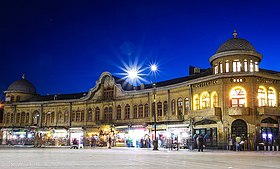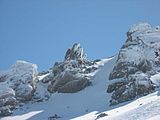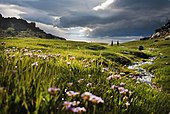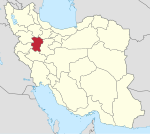Hamadan
This articleneeds additional citations forverification.(December 2023) |
Hamadan
همدان | |
|---|---|
City | |
|
Central square, Nazari Museum garden, Monument, Abbasabad Spa, Quranic and International Convention Center, Tomb of Avicenna | |
| Coordinates:34°47′54″N48°30′53″E/ 34.79833°N 48.51472°E[3] | |
| Country | Iran |
| Province | Hamadan |
| County | Hamadan |
| District | Central |
| Government | |
| • Mayor | Seyed Masoud Hosseini[1] |
| Elevation | 1,850 m (6,069 ft) |
| Population (2016)[2] | |
| • Total | 554,406 |
| • Rank | 13th in Iran |
| Time zone | UTC+3:30(IRST) |
| Website | www |
Hamedan(/ˌhæməˈdæn/HAM-ə-DAN;[4]Persian:همدان,pronounced[hæmeˈdɒːn])[a]is a city in westernIran.It is located in theCentral DistrictofHamadan CountyinHamadan province,serving as the capital of the province, county, and district.[5]As of the 2016 Iranian census, it had a population of 554,406 people in 174,731 households.
Hamadan is believed to be among the oldest Iranian cities. It was referred to in classical sources asEcbatana(Old PersianHamgmatāna). It is possible that it was occupied by theAssyriansin 1100BCE; the Ancient Greek historian,Herodotus,states that it was the capital of theMedes,around 700BCE.
Hamadan is situated in a green mountainous area in the foothills of the 3,574-meter Alvand Mountain, in midwestern Iran. The city is 1,850metersabove sea level.It is located approximately 360 kilometres (220 miles) southwest ofTehran.
The old city and its historic sites attract tourists during the summer. The major sights of this city are theGanj Namehinscription, theAvicennamonument and theBaba Tahermonument. The main language in the city isPersian.[6][7][8]
History
[edit]
According toClifford Edmund Bosworth,"Hamadan is a very old city. It may conceivably, but improbably, be mentioned in cuneiform texts from ca. 1100BC, the time of Assyrian KingTiglath-pilesar I,but is certainly mentioned by Herodotus who says that the king of Media Diokes built the city ofAgbatanaor Ekbatana in the 7th centuryBC. "[9]
Hamadan was established by theMedes.It then became one of several capital cities of theAchaemenid Dynasty.
Hamadan is mentioned in the biblicalbook of Ezra(Ezra 6:2) as the place where a scroll was found giving the Jews permission from King Darius to rebuild the temple in Jerusalem. Its ancient name of Ecbatana is used in the Ezra text. Because it was a mile above sea level, it was a good place to preserve leather documents.
During theParthianera,Ctesiphonwas the capital of the country, and Hamedan was the summer capital and residence of the Parthian rulers. After theParthians,theSassanidsconstructed their summer palaces in this city. In 642 theBattle of Nahavandtook place and Hamadan fell into the hands of the Muslim Arabs.
During the rule of theBuyid dynasty,the city suffered much damage. However, the city regained its former glory under the rule of theBuyidrulerFanna Khusraw.TheSeljukslaunched campaigns to take the city in the 1040s,[10]ultimately taking the final Kakuyid fortress in 1047.[11]The Seljuks later shifted their capital fromBaghdadto Hamadan. In 1220, Hamadan was destroyed by theMongols[12]during theMongol invasions of Georgiabefore theBattle of Khunan.The city of Hamadan, its fortunes following the rise and fall of regional powers, was completely destroyed during theTimurid invasions,but later thrived during theSafavidera.

Thereafter, in the 18th century, Hamadan was surrendered to theOttomans,but due to the work ofNader Shah,Hamadan was cleared of invaders and, as a result of a peace treaty between Iran and the Ottomans, it was returned to Iran. Hamadan stands on theSilk Road,and even in recent centuries the city enjoyed strong commerce and trade as a result of its location on the main road network in the western region of Iran. In the late 19th century, American missionaries, includingJames W. Hawkesand Belle Sherwood Hawke,[13][14]established schools in Hamadan.

DuringWorld War I,the city was the scene of heavy fighting between Russian and Turko-German forces. It was occupied by both armies, and finally by the British, before it was returned to the control of the Iranian government at the end of the war in 1918.
Demographics
[edit]Language
[edit]A majority of the population speaks the Hamadani dialect ofPersianand standard Persian, with aTurkicminority.[15]
Population
[edit]At the time of the 2006 National Census, the city's population was 473,149 in 127,812 households.[16]The following census in 2011 counted 525,794 people in 156,556 households.[17]The 2016 census measured the population of the city as 554,406 people in 174,731 households.[2]
Climate
[edit]Hamadan has ahot-summer, Mediterranean-influenced continental climate(Köppen:Dsa,Trewartha:Dc), in transition with acold semi-arid climate(Köppen:BSk). The city experiences hot, dry summers, and cold, snowy winters. The temperature may drop below −30 °C (−22 °F) on the coldest days. Heavy snowfall is common during winter and this can persist for periods of up to two months. During the short summer, the weather is hot, and mostly sunny.
Lowest recorded temperature: −34.0 °C (−29 °F) on 7 January 1964[18]
Highest recorded temperature: 40.6 °C (105 °F) on 14 July 1989[18]
| Climate data for Hamedan Airport (1991-2020, extremes 1961-2020)[b] | |||||||||||||
|---|---|---|---|---|---|---|---|---|---|---|---|---|---|
| Month | Jan | Feb | Mar | Apr | May | Jun | Jul | Aug | Sep | Oct | Nov | Dec | Year |
| Record high °C (°F) | 17.0 (62.6) |
20.1 (68.2) |
26.2 (79.2) |
30.1 (86.2) |
34.5 (94.1) |
40.6 (105.1) |
40.6 (105.1) |
40.0 (104.0) |
38.0 (100.4) |
30.0 (86.0) |
24.0 (75.2) |
20.4 (68.7) |
40.6 (105.1) |
| Mean daily maximum °C (°F) | 4.1 (39.4) |
7.0 (44.6) |
12.9 (55.2) |
18.3 (64.9) |
23.8 (74.8) |
30.8 (87.4) |
34.8 (94.6) |
34.5 (94.1) |
29.8 (85.6) |
22.4 (72.3) |
13.0 (55.4) |
7.1 (44.8) |
19.9 (67.8) |
| Daily mean °C (°F) | −2.0 (28.4) |
0.8 (33.4) |
6.2 (43.2) |
11.4 (52.5) |
16.1 (61.0) |
21.8 (71.2) |
25.6 (78.1) |
24.9 (76.8) |
19.7 (67.5) |
13.3 (55.9) |
5.9 (42.6) |
0.8 (33.4) |
12.0 (53.7) |
| Mean daily minimum °C (°F) | −7.3 (18.9) |
−4.8 (23.4) |
−0.3 (31.5) |
4.3 (39.7) |
7.6 (45.7) |
11.2 (52.2) |
14.8 (58.6) |
13.8 (56.8) |
8.9 (48.0) |
4.7 (40.5) |
0.0 (32.0) |
−4.3 (24.3) |
4.1 (39.3) |
| Record low °C (°F) | −34 (−29) |
−33.0 (−27.4) |
−26.6 (−15.9) |
−12.0 (10.4) |
−3.0 (26.6) |
2.0 (35.6) |
6.0 (42.8) |
4.0 (39.2) |
−4.0 (24.8) |
−7.0 (19.4) |
−18 (0) |
−29 (−20) |
−34 (−29) |
| Averageprecipitationmm (inches) | 30.6 (1.20) |
38.2 (1.50) |
53.0 (2.09) |
50.9 (2.00) |
23.8 (0.94) |
3.6 (0.14) |
3.5 (0.14) |
2.2 (0.09) |
1.5 (0.06) |
23.9 (0.94) |
44.0 (1.73) |
40.0 (1.57) |
315.2 (12.4) |
| Average precipitation days(≥ 1.0 mm) | 6.5 | 6.3 | 7.0 | 7.3 | 4.5 | 0.7 | 0.6 | 0.2 | 0.4 | 3.1 | 6.0 | 6.0 | 48.6 |
| Average snowy days | 6.9 | 6.1 | 3.3 | 0.3 | 0.1 | 0 | 0 | 0 | 0 | 0 | 0.8 | 4.5 | 22 |
| Averagerelative humidity(%) | 73 | 68 | 57 | 54 | 49 | 37 | 31 | 29 | 31 | 45 | 64 | 72 | 50.8 |
| Averagedew point°C (°F) | −7.5 (18.5) |
−5.9 (21.4) |
−4.2 (24.4) |
−0.4 (31.3) |
2.4 (36.3) |
3.1 (37.6) |
4.1 (39.4) |
2.5 (36.5) |
−0.7 (30.7) |
−1.4 (29.5) |
−2.3 (27.9) |
−5.3 (22.5) |
−1.3 (29.7) |
| Mean monthlysunshine hours | 160 | 177 | 217 | 233 | 296 | 355 | 346 | 340 | 314 | 259 | 177 | 153 | 3,027 |
| Source 1: NOAA[19][18](snow/sleet days for 1981-2010[20]) | |||||||||||||
| Source 2: IRIMO(extremes[21][22]) | |||||||||||||
-
Heydare, Hamadan
-
AlvandMountain
-
Mishan, a plain of Alvand Mountain
-
Hamadan spot (light blue in center) in Hamadan province topography map


Gallery
[edit]-
Tomb ofBaba Taher
-
Inside the tomb of Baba Taher
-
The Tomb ofAvicenna
-
The handwriting ofCanon of Medicinein the Tomb of Avicenna
-
Tomb of Esther and Mordechai,a tomb believed by some to hold the remains of Esther and Mordechai
-
Inside the structure alleged by some to be the Tomb of Esther and Mordechai
-
Emamzade Abdollah Mosque
-
Alaviyan Domerelated withMir Sayyid Ali Hamadani
-
Qorban Tower
-
Hamedan Central Square
Sport
[edit]PAS Hamedan F.C.were founded on June 9, 2007 after the dissolution ofPAS Tehran F.C.The team, along withAlvand Hamedan F.C.,is in theAzadegan League.
Some sport complexes in this city include:Qods Stadium,Shahid Mofatteh Stadium,Takhti Sport Complex and the National Stadium of Hamadan.
Education
[edit]
Before thePersian Constitutional Revolution,education in Hamadan was limited to someMaktabHouses and theological schools. Fakhrie Mozafari School was the first modern school of Hamadan, which was built after that revolution. Alliance and Lazarist were also the first modern schools founded by foreign institutions in Hamadan.
Some of the popular universities in Hamadan include:
- Bu-Ali Sina University[24]
- Hamadan Medical University[25]
- Hamadan University of Technology[26]
- Islamic Azad University of Hamadan[27]
Notable people
[edit]Hamedan celebrities are divided into 3 categories: pre-Islamic, post-Islamic and contemporary people.
Pre-Islamic celebrities
[edit]Among the pre-Islamic celebrities in Hamedan, we can name Mandana, the mother ofCyrus the Greatand the daughter of the last king of Media, Ishtovigo.
Famous names after Islam
[edit]Famous people of Hamedan after Islam are great people such as:
- Baba Taher,Famous poets of the fourth century AH.
- Badi'alzaman Hamedani, author of the oldest book in the art of maqam writing.
- Abul Ali Hassan Attar, a greatliteratureand famous syntax, vocabulary and hadith in the fourth century AH.
- Tomb of Esther and Mordekhai, The Tomb of Esther and Mordechai is a tomb located in Hamadan, Iran. Iranian Jews and Iranian Christians believe it houses the remains of the biblical Queen Esther and her cousin Mordechai, and it is the most important pilgrimage site for Jews and Christians in Iran.
- Ibn Salah Hamedani,physicianandmathematicianof the fifth and sixth centuries AH.
- Khajeh Rashid al-Din Fazlullah, minister, scientist and expert physician of the sixth and seventh centuries AH.
- Mir Sayyid Ali Hamadani,Mystics and followers of Sirusluk of the seventh century AH.
- Mirzadeh Eshghi is one of the shining stars of poetry and prose of the play during the Constitutional Revolution.
- Bu Ali Sina,one of the rarescientistsand geniuses of the time, was born in 370 AH in Khoramisin, Bukhara. He entered this city in 406 AH when Hamedan was the capital of thebuyid,and after a while, Shams al-Dawla Dailami made him his minister. During his stay in Hamedan, Bu Ali Sina taught at the city's large school and had the opportunity to complete many of his writings.
- The tomb of Bu Ali Sina is now located in a square of the same name in Hamedan.
Contemporary people
[edit]
- Abolhassan Banisadr(1933–2021), economist, politician, and the first post-revolutionary elected president of the Islamic Republic of Iran

Fazlollah Zahediand his family - Ahmad NikTalab(1934–2020), a famous contemporary poet
- Aminollah Rezaei(1936–2004), poet, the Father of IranianSurrealism
- Amir Nosrat'ollah Balakhanlou,born in Tehran — two-time mayor and MP for Hamadan City (1950s and early 1960s)
- Amir-Shahab Razavian(born 1965), film director, writer and producer
- Baba-Taher-e Oryan,a famous poet (1100 AD)

Abolhassan Banisadr - Ein-Alqozat Hamadani(1098–1131), a great philosopher and sufist (1100 AD)
- Ehsan Yarshater(1920–2018), historian, scientists, and founder of Encyclopædia Iranica
- Fakhr-al-Din Iraqi,celebrated poet (1300 AD)
- Fazlollah Zahedi(1892–1963), military general
- Fereydoun Moshiri,contemporary poet (originally from Hamadan, but born in Tehran)
- Hossein Noori Hamedani(born 1925), Iranian Shia Marja
- Hanieh Tavassoli(born 1979), actress
- Joseph Emin(born 1726), a major activist in the attempts to liberate Armenia during the 18th century
- Mir Sayyid Ali Hamadani(1312–1384), poet and scholar
- Mirzadeh Eshghi(1893–1924), a celebrated nationalist poet
- Moshfegh Hamadani(1912–2009), writer, journalist and translator
- Parviz Parastouei,acclaimed actor
- Rashid-al-Din Hamadani,Persian statesman, historian and physician of the 13th-14th centuries
- Shirin Ebadi,lawyer and the 2003Nobel Peace Laureate
- Samuel Rahbar,scientist
- Wojtek,a bear who was born in Hamedan and would grow up to become a corporal in the Polish army during World War 2.
- Viguen,known as the king of Persian pop and jazz music
International relations
[edit]Twin towns – Sister cities
[edit]Hamadan istwinnedwith:
See also
[edit]- Ganj Nameh
- Mir Sayyid Ali Hamadani
- Baba Taher Orian
- Ali Sadr Cave
- Hamadan Airport
- Wojtek (soldier bear)
References
[edit]- ^"سیدمسعود حسینی شهردار همدان شد".Mehr News(in Persian). 4 September 2021.Retrieved9 April2024.
- ^ab"Census of the Islamic Republic of Iran, 1395 (2016)".AMAR(in Persian). The Statistical Center of Iran. p. 13. Archived fromthe original(Excel)on 21 April 2021.Retrieved19 December2022.
- ^OpenStreetMap contributors (17 October 2023)."Hamadan, Hamadan County"(Map).OpenStreetMap(in Persian).Retrieved17 October2023.
- ^"Hamadan".Merriam-Webster Dictionary.Retrieved16 June2023.
- ^Habibi, Hassan (21 June 1369)."Approval of the organization and chain of citizenship of the elements and units of the country's divisions of Hamadan province, centered in Hamadan city".Lamtakam(in Persian). Ministry of Interior, Political Defense Commission of the Government Board. Archived fromthe originalon 11 February 2024.Retrieved11 February2024.
- ^"Introduction".hamedan.rmto.ir.Archived fromthe originalon 22 December 2015.Retrieved20 December2015.
- ^Mohammad Jalal Abbasi-Shavazi, Peter McDonald, Meimanat Hosseini-Chavoshi, "The Fertility Transition in Iran: Revolution and Reproduction", Springer, 2009. pp 100-101: "The first category is 'Central' where the majority of people are Persian speaking ethnic Fars (provinces of Fars, Hamedan, Isfahan, Markazi, Qazvin, Qom, Semnan, Yazd and Tehran..."
- ^(Parviz Aḏkāʾi and EIr, HAMADĀN i. GEOGRAPHY in Encyclopædia Iranica: "Languages spoken. Hamedān has been a crossroads of civilizations for millennia and a mosaic of cultures and dialects live there side by side. The main language spoken,especially in the provincial capitaland its surroundings, is Persian, which is also the lingua franca in other regions. In the northern parts of the province, however, the language mostly spoken is Azeri Turkish, while in the northwest and west, near the provinces of Kurdistan and Kermānšāhān, people mostly speak Kurdish, while in some other cities such as Malāyer, Nehāvand, and Sāmen most people speakLoriand Lak (Faraji, p. 1296). "
- ^Bosworth, Clifford Edmund (2008).Historic Cities of the Islamic World.Brill Academic Publishers. p. 151.ISBN978-90-04-15388-2.
- ^C. E. Bosworth, “ABŪ KĀLĪJĀR GARŠĀSP (I),”Encyclopædia Iranica,I/3, p. 328; an updated version is available online athttp:// iranicaonline.org/articles/abu-kalijar-garsasp-i-ala-al-dawla-second-son-of-the-kakuyid-amir-of-jebal-ala-al-dawla-mohammad-b(accessed on 23 January 2024).
- ^C. E. Bosworth, “KĀKUYIDS,”Encyclopædia Iranica,Vol. XV, Fasc. 4, pp. 359-362; an updated version is available online athttps:// iranicaonline.org/articles/kuyids-dynasty(accessed on 23 January 2024).
- ^"Hamadan | Iran | Britannica".britannica.Retrieved16 January2022.
- ^James W. Hawkes Collection,Rare Books and Manuscripts Division, Indiana State Library.
- ^Zirinsky, Michael P. (1992)."Harbingers of Change: Presbyterian Women in Iran, 1883—1949".American Presbyterians.70(3): 173–186.ISSN0886-5159.JSTOR23333052.
- ^"Language distribution: Hamadan Province - Hamadān".Retrieved4 May2023.
- ^"Census of the Islamic Republic of Iran, 1385 (2006)".AMAR(in Persian). The Statistical Center of Iran. p. 13. Archived fromthe original(Excel)on 20 September 2011.Retrieved25 September2022.
- ^"Census of the Islamic Republic of Iran, 1390 (2011)".Syracuse University(in Persian). The Statistical Center of Iran. p. 13. Archived fromthe original(Excel)on 17 January 2023.Retrieved19 December2022.
- ^abc"HAMEDAN NOZHEH - WMO Station Number: 40767".ncei.noaa.gov(TXT).National Oceanic and Atmosoheric Administration.Retrieved24 April2024.
- ^"World Meteorological Organization climate normals for 1991-2020: Hamedan airport-40768"(CSV).ncei.noaa.gov(Excel).National Oceanic and Atmosoheric Administration.Retrieved28 March2024.
- ^"World Meteorological Organization Climate Normals for 1981-2010: Hamedan airport-40768".ncei.noaa.gov.NOAA.Retrieved28 March2024.
- ^"TEMPERATURE RECORDS HIGHEST IN C. for Hamedan airport".chaharmahalmet.Iran Meteorological Organization. Archived from the original on 16 May 2013.Retrieved28 March2024.
{{cite web}}:CS1 maint: unfit URL (link) - ^"TEMPERATURE RECORDS LOWEST IN C. for Hamedan airport".chaharmahalmet.Iran Meteorological Organization. Archived from the original on 10 September 2014.Retrieved28 March2024.
{{cite web}}:CS1 maint: unfit URL (link) - ^Subani, Hamad (2013).The Secret History of Iran.Lulu. p. 19.ISBN9781304082893.[self-published source]
- ^"صفحه اصلی - دانشگاه بوعلی سینا".basu.ac.ir.
- ^"Hamadan Medical University Website".umsha.ac.ir.
- ^"Hamedan University of Technology Website".Archived fromthe originalon 16 September 2009.Retrieved17 March2007.
- ^"Welcome to Website Islamic Azad University of Hamedan Branch".11 March 2005. Archived fromthe originalon 11 March 2005.Retrieved30 August2020.
- ^"خبرگزاری فارس -" بخارا "زادگاه و" همدان "مدفن بوعلیسینا خواهرخوانده میشوند".خبرگزاری فارس.23 November 2011.
Bibliography
[edit]External links
[edit]![]() Media related toHamadanat Wikimedia Commons
Media related toHamadanat Wikimedia Commons
- Ecbatana,Photos from Iran,LiviusArchived26 October 2008 at theWayback Machine.
- Gandj Nameh,Photos from Iran,LiviusArchived18 September 2008 at theWayback Machine.
- The Bisotun inscription,Photos from Iran,LiviusArchived2016-03-03 at theWayback Machine.
- Photos from Hamadan CityArchived2007-09-27 at theWayback Machine
- Hamadan City
- Hamadan: Older than history
- Hamadan; Capital of Median Empire
- Iconos satellite photo (January, 2005)
- Google Satellite Picture
- Hamedan Cultural Heritage Organization(in Persian)
- Hegmataneh Official WebsiteArchived2008-04-22 at theWayback Machine
- Hamadānentries in the

























